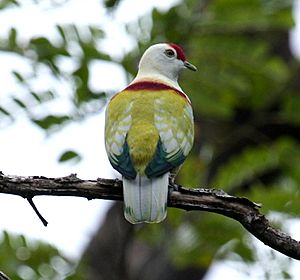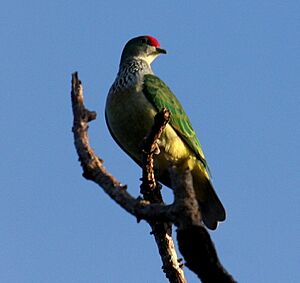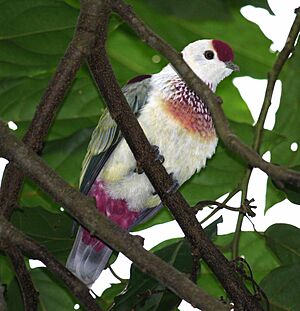Many-colored fruit dove facts for kids
Quick facts for kids Many-colored fruit doveTemporal range: Quaternary
|
|
|---|---|
 |
|
| Conservation status | |
| Scientific classification | |
| Genus: |
Ptilinopus
|
| Species: |
perousii
|
|
|
The many-colored fruit dove (Ptilinopus perousii) is a beautiful bird found on islands in the south-west Pacific Ocean. People in Samoa call it manuma. This dove lives in countries like Fiji, the Samoan Islands, and Tonga.
You can usually find these birds in warm, wet forests close to the sea. Today, they are most common in Fiji and Tonga. They like to eat fruit and berries high up in the trees. Their favorite food is the banyan fig. Many-colored fruit doves build a small nest from twigs. They lay just one white egg in it.
Contents
What Does the Many-colored Fruit Dove Look Like?
This is a small dove, about 23 cm (9.1 in) long. Adult birds weigh around 90 g (3.2 oz). The male bird is mostly pale yellow-white. It has a red cap on its head and a red stripe across its back.
The female many-colored fruit dove is mostly green. Her back is darker green, and her head and chest are greyer. She also has a red cap. The feathers under her tail are red if she is from Samoa. If she is from Fiji or Tonga, these feathers are yellow.
How Scientists Classify This Bird
The many-colored fruit dove belongs to the Columbidae family. This is the same family as all other doves and pigeons. It is a type of fruit dove, which means it is in the genus Ptilinopus.
This bird is special because it lives only on the South Pacific islands. It does not have many close relatives. There are two types, or subspecies, of this bird. They are called Ptilinopus perousii mariae and P. p. perousii. The mariae subspecies lives in Fiji and Tonga.
The English name "many-colored fruit dove" describes the bird well. It has many colors and eats fruit. Its Samoan name, manuma, means "shy bird." This name comes from Samoan words for "bird" and "shame." The Latin name honors Captain Jean Francois de Galaup Comte de la Pérouse. He was a French navy captain who explored the Pacific Ocean.
Where Do Many-colored Fruit Doves Live?
Manuma birds live on many islands across Polynesia. Their home range covers a huge area, about 660,000 square kilometers. You will find them most often in Fiji and Tonga.
They live in warm, wet forests with broadleaf trees. In these forests, they spend their time high up in the tree branches. Sometimes, you can even find them in towns and cities. These birds have been around for a very long time. Their fossils show they have lived here for at least 120,000 years, since the Quaternary period.
Behavior and Life
What Do Many-colored Fruit Doves Eat?
The many-colored fruit dove is a frugivore. This means it eats only fruit. It searches the tops of trees for figs. On the islands of Samoa and American Samoa, their main food is the fruit from banyan trees.
Eating only certain figs helps keep those fig trees healthy. But it also means if there are fewer figs, the doves might struggle. In Fiji and Tonga, manuma also eat fruits from other trees. These include ylang ylang (Cananga odorata), bishop wood (Bischofia javanica), and māgele (Trema cannabina).
How Do They Interact?
Many-colored fruit doves often live in small groups, called flocks. In these flocks, there are usually more male birds than female birds.
Status and Conservation
The International Union for Conservation of Nature (IUCN) does not list the many-colored fruit dove as threatened. However, its numbers are going down in American Samoa. The decline is not yet severe enough to change its conservation status. Also, the area where it lives is not considered too small for it to be vulnerable.
In the past, during the 1800s and early 1900s, there were many of these birds on Tutuila, American Samoa. By the 1970s, a study found only about 80 birds there. In the 1990s, this number dropped to 50 birds on Tutuila.
Scientists are working to help these birds. Biologists from the American Samoa Department of Marine and Wildlife Resources and other groups have captured some doves. They started a project to breed them in zoos. This project is happening at facilities of the Association of Zoos and Aquariums.
One big problem for the many-colored fruit dove is the decline of its main food source, the banyan fruit. Banyan trees are being cut down. They also get damaged easily by storms. In the 1990s, strong storms like Cyclone Val and Cyclone Ofa hurt many banyan trees. They either killed them or stripped them of their leaves and fruit.
Hunting is another reason for the bird's decline on Tutuila. Hunters looking for other birds, like the lupe (Pacific imperial pigeon) or manutagi (purple-capped fruit-doves), sometimes accidentally shoot many-colored fruit doves. Surveys showed that more than a quarter of hunters reported accidentally shooting one of these doves.




